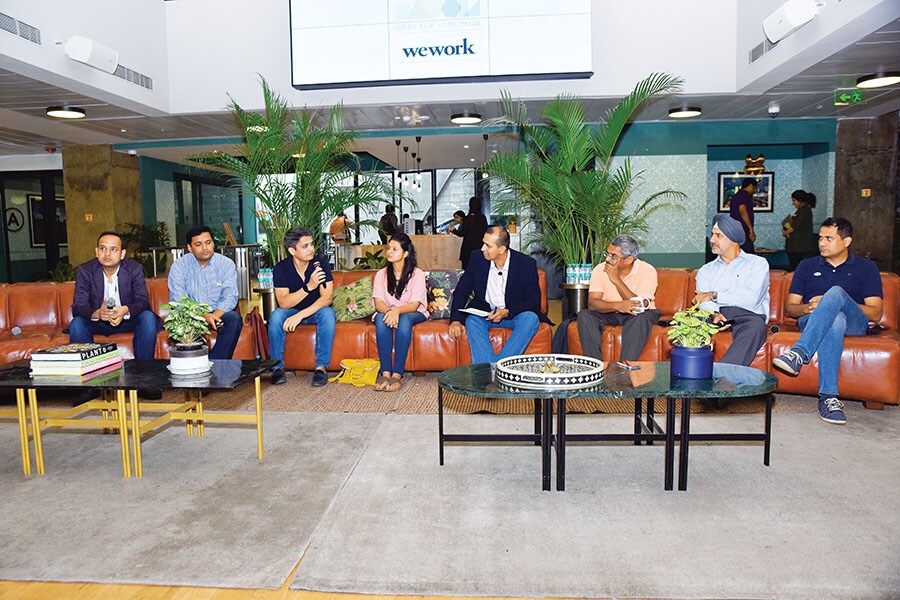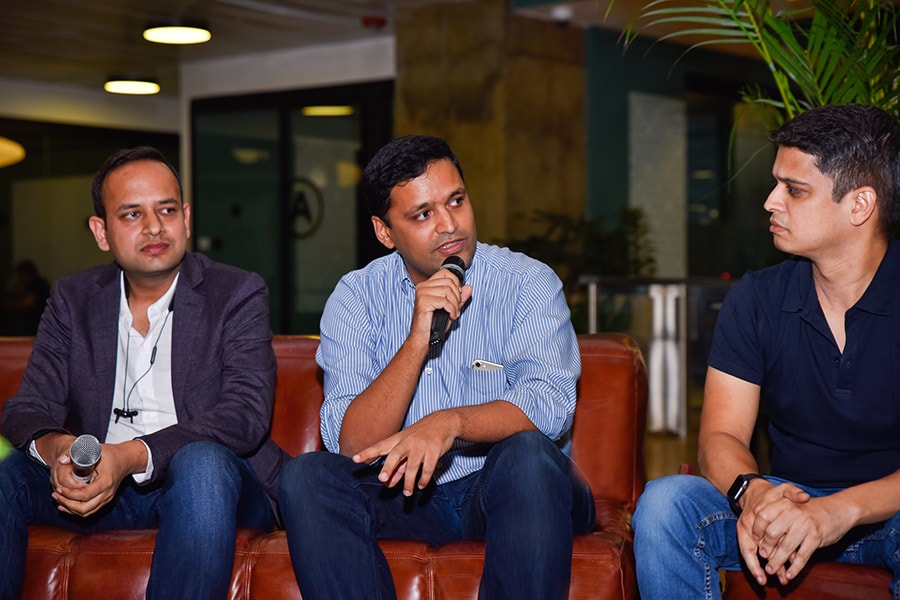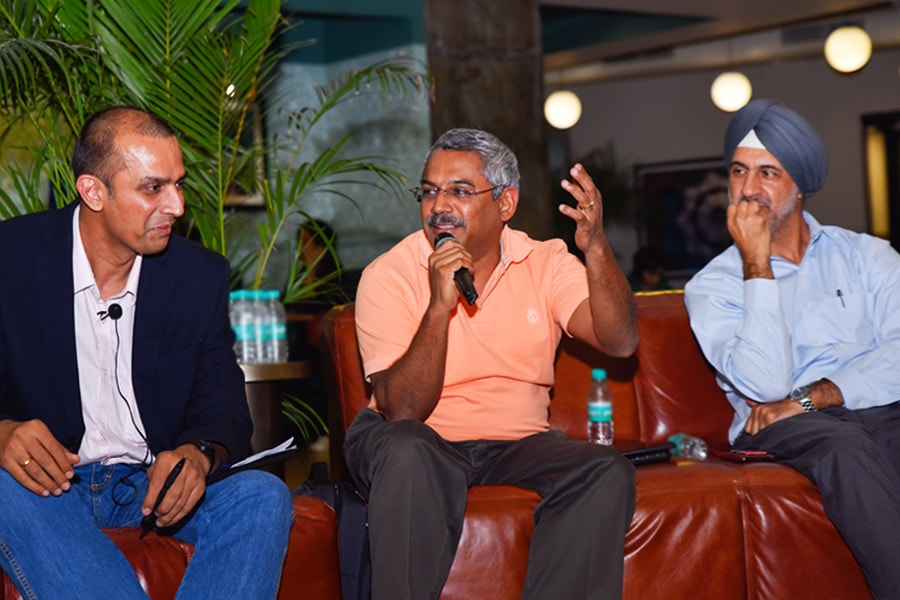
Beyond Ecommerce: Is it the era of products?
Industry leaders discuss the scope for product startups, and the change in the nature of funding
 (From left) Vikas Agarwal, Vinod Murali, Prasad Kompalli, Suhasini Sampath, Harichandan Arakali, Sanjay Swamy, Kanwaljit Singh, Ritesh Banglani
(From left) Vikas Agarwal, Vinod Murali, Prasad Kompalli, Suhasini Sampath, Harichandan Arakali, Sanjay Swamy, Kanwaljit Singh, Ritesh BanglaniPhotographs: Guru Prasad S for Forbes India
India’s ecommerce juggernaut continues to roll. American retail giant Walmart bought Flipkart for $16 billion in May, while food delivery startup Swiggy raised $210 million in June, which gave it a valuation of $1.3 billion. While these large fundings continue to hog the limelight, the question remains: What is the road ahead for product-focussed startups, either consumer or tech?
At the third edition of the Forbes India Startup Square, held in association with WeWork India in Bengaluru in June, an eminent panel gave its views on ‘Beyond Ecommerce: The Era of Products’. Those who gave their insights on the subject were Sanjay Swamy, managing partner, Prime Venture Partners, Prasad Kompalli, CEO and co-founder, mfine, Kanwaljit Singh, founder, Fireside Ventures, Vikas Agarwal, general manager, OnePlus India, Vinod Murali, managing partner, Alteria Capital, Suhasini Sampath, founder, Yoga Bar, and Ritesh Banglani, partner, Stellaris Venture Partners. The hour-long discussion was moderated by Harichandan Arakali, editor-technology, Forbes India. Edited excerpts:
Harichandan Arakali: What is changing in terms of the type of new ventures, and the people starting them? What kind of verticals are seeing an uptake?
Ritesh Banglani: We are starting to see an interesting set of entrepreneurs emerge over the last couple of years; people who have previously worked at startups, not as founders, but as executives and managers. Prasad [Kompalli] is one of them. He used to be the chief business officer at Myntra and has seen both the upcycles and down cycles of that company. He has also experienced how to take a company from zero to a billion dollars [gross merchandise volume].
Prasad Kompalli: The ecosystem is much more supportive and ready to bet on product innovations. Besides, there is a lot more talent available to build great products.
 (Left to Right) Vikas Agarwal, general manager, OnePlus India, Vinod Murali, managing partner, Alteria Capital & Prasad Kompalli, CEO and co-founder, mfine
(Left to Right) Vikas Agarwal, general manager, OnePlus India, Vinod Murali, managing partner, Alteria Capital & Prasad Kompalli, CEO and co-founder, mfine
At the third edition of the Forbes India Startup Square, held in association with WeWork India in Bengaluru in June, an eminent panel gave its views on ‘Beyond Ecommerce: The Era of Products’. Those who gave their insights on the subject were Sanjay Swamy, managing partner, Prime Venture Partners, Prasad Kompalli, CEO and co-founder, mfine, Kanwaljit Singh, founder, Fireside Ventures, Vikas Agarwal, general manager, OnePlus India, Vinod Murali, managing partner, Alteria Capital, Suhasini Sampath, founder, Yoga Bar, and Ritesh Banglani, partner, Stellaris Venture Partners. The hour-long discussion was moderated by Harichandan Arakali, editor-technology, Forbes India. Edited excerpts:
Harichandan Arakali: What is changing in terms of the type of new ventures, and the people starting them? What kind of verticals are seeing an uptake?
Ritesh Banglani: We are starting to see an interesting set of entrepreneurs emerge over the last couple of years; people who have previously worked at startups, not as founders, but as executives and managers. Prasad [Kompalli] is one of them. He used to be the chief business officer at Myntra and has seen both the upcycles and down cycles of that company. He has also experienced how to take a company from zero to a billion dollars [gross merchandise volume].
Prasad Kompalli: The ecosystem is much more supportive and ready to bet on product innovations. Besides, there is a lot more talent available to build great products.
 (Left to Right) Vikas Agarwal, general manager, OnePlus India, Vinod Murali, managing partner, Alteria Capital & Prasad Kompalli, CEO and co-founder, mfine
(Left to Right) Vikas Agarwal, general manager, OnePlus India, Vinod Murali, managing partner, Alteria Capital & Prasad Kompalli, CEO and co-founder, mfine Suhasini Sampath: We have investors who are now backing product companies that are non-tech-focussed, which is a big step forward. You also have banks funding non-tech startups. Besides, on the distribution side, the likes of Amazon and BigBasket have programmes that are specifically targeted for startups, which is great.
Kanwaljit Singh: What prompted some of us to get into the consumer branded space was a change not just in the entrepreneurial activity, but also starting first with the market dynamics. The rise of the millennial consumer is fuelling a desire for branded and innovative products; it’s a different consumer that you are catering to. The market has evolved in favour of consumer brands, and entrepreneurs have started to realise that.
However, tech is still the larger, pervasive, entrepreneurial area of interest. I slightly differ with Suhasini’s views on one point: We don’t have enough investors who are investing in this space or understand enough about the dynamics of building brands.
Arakali: Talking about millennial consumers, OnePlus [the four-year-old premium Chinese smartphone company] is doing spectacularly well [in India]. Vikas, what has been the OnePlus experience so far?
Vikas Agarwal: When we entered, everybody told us that India is a low-cost market and that the purchasing power for a premium product like OnePlus was not there, especially through online sales. From our experience, if you deliver good service, a great product and experience, there are customers who are willing to pay [a premium], whether you are buying online or offline. We have been able to deliver on that, which has made us so successful.
Arakali: Sanjay, Vinod, what stage of maturity is our startup ecosystem at, and what’s the kind of capital chasing startups?
Sanjay Swamy: We are at an interesting inflection point in India. The real problems that Indian startups can [and should] solve will be India-specific, which hopefully they will understand better. The opportunity is big, and there are a lot of people eyeing it. So they [Indian startups] have to move fast.
That said, the Chinese model has been to throw a lot of money at a problem quickly and burgeon its way into the market. While the same product ideas might have value in India, implementation will be dramatically different. That’s the differentiation the Indian startups should leverage. The big theme that we are investing a lot on is digitisation, especially in sectors such as health care, logistics and education.
 (Left to Right) Harichandan Arakali, editor-technology, Forbes India, Sanjay Swamy, managing partner, Prime Venture Partners, & Kanwaljit Singh, founder, Fireside Ventures
(Left to Right) Harichandan Arakali, editor-technology, Forbes India, Sanjay Swamy, managing partner, Prime Venture Partners, & Kanwaljit Singh, founder, Fireside Ventures Vinod Murali: Look at the India of 2006-09 vis-à-vis Silicon Valley: If series A funding was $5 million there, it was the same here. One did not test whether one needed $5 million, $2 million or $10 million. So questions such as ‘What is a good seed, series A and series B round of funding?’ or ‘Am I ready for the next round of capital?’ are now better understood [by both entrepreneurs and venture capitalists]. You can build a good business with $10 million and still have a good outcome for everyone concerned.
 Agarwal: The funding mix has changed. Five to seven years ago, it was largely the global VCs investing in India. Today, a majority of the deals are by Chinese firms. Of course, Softbank is there. These companies are looking for big deals; they have seen how success plays out in creating multi-billion dollar industries and are bringing that expertise and money [to India]. For example, Alibaba has invested in Paytm and Zomato. The VCs are focusing on B2B [business-to-business] product firms that need lesser money because their cash burn is much lower than B2C [business-to-consumer] companies.
Agarwal: The funding mix has changed. Five to seven years ago, it was largely the global VCs investing in India. Today, a majority of the deals are by Chinese firms. Of course, Softbank is there. These companies are looking for big deals; they have seen how success plays out in creating multi-billion dollar industries and are bringing that expertise and money [to India]. For example, Alibaba has invested in Paytm and Zomato. The VCs are focusing on B2B [business-to-business] product firms that need lesser money because their cash burn is much lower than B2C [business-to-consumer] companies.
Singh: If you want to promote entrepreneurship at a much broader level, it cannot just be about writing large cheques for a few companies. It has to be for a wider spread and that’s the narrative that’s starting to happen. However, VCs are getting a little isolated because unless you have a big brother writing a big cheque, the next step for your company becomes a question mark.
Swamy: Venture capital is like a treadmill. The more [money] there is, the faster you need to run. My advice is: Don’t get too carried away by what you need, and don’t raise too much just because people are throwing money at a problem. A lot of these funding deals, which are north of $50 million, add up to 10 companies in India. And there are 4,000 startups founded every year in Bengaluru alone!
Banglani: It’s not one versus the other—get funded by a VC or by, say, a Tencent. Both these sources of capital have their niches. A large Chinese company is a distribution and financing machine more than anything else: You get capital from Tencent and you also get a large mass of consumers in China. Likewise, you get funded by a Flipkart and you get a large base of online consumers. The function of a VC is completely different; it converts experiments into companies. Not all experiments would work out, may be two out of 10.
Arakali: What is the entrepreneurs’ view on this?
Sampath: In the FMCG space, you have to be focussed on building products and not throw money behind a problem. You have to be careful in the way you capitalise your balance sheet and grow your company. It’s not possible to grow from zero to a billion dollars in a short span of time. There are examples in the US of companies in our category that have built multi-billion dollar companies, but over a 10-year period.
Kompalli: The good news is that there is a lot of opportunity now compared to 10 years ago. Ecommerce was unimaginable then, but now it’s a norm. In the same way, in the health care and financial services space, a lot more things are tech-driven as consumers are demanding certain kind of services. I’m more excited about these opportunities and trying to use them rather than getting into the discussion of what gets funded and what does not get funded.
 Agarwal: The funding mix has changed. Five to seven years ago, it was largely the global VCs investing in India. Today, a majority of the deals are by Chinese firms. Of course, Softbank is there. These companies are looking for big deals; they have seen how success plays out in creating multi-billion dollar industries and are bringing that expertise and money [to India]. For example, Alibaba has invested in Paytm and Zomato. The VCs are focusing on B2B [business-to-business] product firms that need lesser money because their cash burn is much lower than B2C [business-to-consumer] companies.
Agarwal: The funding mix has changed. Five to seven years ago, it was largely the global VCs investing in India. Today, a majority of the deals are by Chinese firms. Of course, Softbank is there. These companies are looking for big deals; they have seen how success plays out in creating multi-billion dollar industries and are bringing that expertise and money [to India]. For example, Alibaba has invested in Paytm and Zomato. The VCs are focusing on B2B [business-to-business] product firms that need lesser money because their cash burn is much lower than B2C [business-to-consumer] companies.Singh: If you want to promote entrepreneurship at a much broader level, it cannot just be about writing large cheques for a few companies. It has to be for a wider spread and that’s the narrative that’s starting to happen. However, VCs are getting a little isolated because unless you have a big brother writing a big cheque, the next step for your company becomes a question mark.
Swamy: Venture capital is like a treadmill. The more [money] there is, the faster you need to run. My advice is: Don’t get too carried away by what you need, and don’t raise too much just because people are throwing money at a problem. A lot of these funding deals, which are north of $50 million, add up to 10 companies in India. And there are 4,000 startups founded every year in Bengaluru alone!
Banglani: It’s not one versus the other—get funded by a VC or by, say, a Tencent. Both these sources of capital have their niches. A large Chinese company is a distribution and financing machine more than anything else: You get capital from Tencent and you also get a large mass of consumers in China. Likewise, you get funded by a Flipkart and you get a large base of online consumers. The function of a VC is completely different; it converts experiments into companies. Not all experiments would work out, may be two out of 10.
Arakali: What is the entrepreneurs’ view on this?
Sampath: In the FMCG space, you have to be focussed on building products and not throw money behind a problem. You have to be careful in the way you capitalise your balance sheet and grow your company. It’s not possible to grow from zero to a billion dollars in a short span of time. There are examples in the US of companies in our category that have built multi-billion dollar companies, but over a 10-year period.
Kompalli: The good news is that there is a lot of opportunity now compared to 10 years ago. Ecommerce was unimaginable then, but now it’s a norm. In the same way, in the health care and financial services space, a lot more things are tech-driven as consumers are demanding certain kind of services. I’m more excited about these opportunities and trying to use them rather than getting into the discussion of what gets funded and what does not get funded.
X














